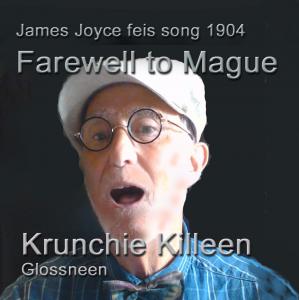Remembering A Song Sung By James Joyce In A Competition In 1904
Krunchie Killeen Releases A Recording Of The Song (“Farewell To Mague”) Sung By James Joyce At the Feis Ceoil Competition In 1904
“Farewell to Mague,” otherwise known as “A Long Farewell,” (the opening words of the song), is a translation by Edward Walsh of the Irish language song “Slán Le Máigh,” by Aindrias Mac Craith (“McGrath” in English) (1709 to 1795), arranged by Alfred Moffat (1863 to 1950) and included in Moffat’s “Minstrelsy of Ireland,” a collection of 200 Irish folk songs, with piano accompaniment.
The author of the original song, Aindrias Mac Craith, nicknamed “The Merry Pedlar,” was an impoverished Catholic hedge-school teacher. The word “merry” in his nickname infers inebriation. This nickname was given to him by Seán Ó Tuama An Ghrinn (“John Twomey the Joker”), a pub-owner in the town of Croom, the chief town of the Mague district. Tradition has it that when Twomey first saw him, Mac Craith carried a piece of cloth under his arm, (which he intended to have made into a coat), so Twomey took him to be a pedlar and that, after a quick exchange of witticisms, the two became life-long friends.
According to folklore, Twomey had pinned over the door of his hostelry a notice, in verse, that all poets were welcome and would be provided with free drink. Free drink for performers is not unusual in Ireland, and often provides pub owners with a cheap way of providing entertainment, as well as a low-cost venue for musicians. Twomey was, however, very generous and eventually bankrupted his business by providing excessive free drink to wasters.
Mac Craith had never written a poem before, but promptly composed a poem to qualify for the free drink. With Irish culture in severe decline at the time, Twomey was concerned to keep poetry-writing alive, and turned his hostelry into a venue for poets to practice their art. Twomey and Mac Craith were the two leading lights of this academy of “Mague Poets,” and constantly entertained the other customers with their quick-witted duelling verses. (An alternative version is that the two poets actually fell out and that the duelling verses were deadly serious mutual criticisms).
Whatever the truth, the most popular verse form used by the pair in this critical exchange became known as the “Limerick,” when it was widely emulated and taken by Limerick people emigrating to London.
The Hedge Schools: Ireland had been decimated by wars in the 17th century. In the middle of that century, Oliver Cromwell, having defeated the Irish rebels, confiscated all the land of the Catholic population and doled it out to Protestant soldiers and adventurers, the new landlord class. Later in the century, Under King William and Queen Ann, Penal Laws were passed that prohibited Catholics from owning land. All Catholic schools and colleges were closed and all Catholic ceremonies prohibited. Teachers, like Aindreas Mac Craith, hired their skills wherever they could. When their present pupils ran out of money, they moved on to beg for employment elsewhere.
Not surprisingly, Mac Craith was a Jacobite and part of his criticism of Twomey was the latter’s lack of commitment to the Jacobite cause.
Like many other hedge-school masters, Mac Craith was fond of fun, sport, good company, deep drinking, beautiful young women, and practical jokes. He was eventually banished from Croom by the priests, because of bad behaviour, and settled about sixteen miles away in Ballyneety. Here he wrote his magnificent song of exile, “Slán Le Máigh.” He expresses a broken heart for Mague, but in an exuberant flow of beautiful words, full of assonance and alliteration. He was a sweet singer and his song was popular with pub audiences.
Despite his excessive drinking, womanising, general bad behaviour and denouncement by priests, it seems that he continued to earn his living as a teacher throughout his life; his real reason for leaving Croom (and the Mague) was probably to take up a teaching post; the broken heart at leaving Mague no more than a good subject for a song.
Mac Craith’s life-story is discussed in the Dictionary of Irish Biography: https://dib.cambridge.org/viewReadPage.do?articleId=a5023&searchClicked=clicked&quickadvsearch=yes
Walsh’s translation gives the sense of the poem, but, of course, lacks the flamboyance and assonance of the original.
Like many Irish musicians, Krunchie Killeen has known the tune for years.
Usually, Krunchie would, on Bloomsday (16 June), with other members of the Invincibles, provide music for the “All Day Breakfast,” in the local Day Care Centre, but this year, 2020, there was no concert because of the Covid lockdown. On the day, Krunchie took it into his head, instead, to record “Farewell to Mague” as Joyce would have sung it at the Feis Ceoil in 1904, and this is how he spent Bloomsday this year.
Being a poor reader of music, Krunchie decided to create his own simple arrangement, instead of studying Moffat’s, and recorded the song in A Major (natural) (a key favoured by tin-whistle players) instead of Moffat’s A Flat. Instead of limiting the accompaniment to piano, as it would have been in the competition, he added some instruments to make it more interesting (Violin, Trombone, Trumpet and Harmonica, all virtual).
Krunchie’s rendering of the song is found on Spotify at:
https://open.spotify.com/album/1U3aXafxScbfgzvNePCgv9?si=We-1yyywRG-SLpZ8WS2YyA
The Irish words of the song are on the Web at: https://songsinirish.com/slan-le-maigh-lyrics/
Moffat’s Irish Minstrelsy is on the Web at: https://www.itma.ie/digital-library/text/moffat-minstrelsy-of-ireland-206-irish-songs1
A selection of photos of Krunchie can be viewed and downloaded from:
https://p-ocillin.tkhcloudstorage.com/item/c3e7ed8999a2452a8cce961491f421cf
Krunchie uses “Glossneen” as his record label. The range of recordings so far issued under the “Glosneen” label can be found here: https://Glossneen.blogspot.com/
A selection of his Album Art is found on Pinterest at: https://www.pinterest.ie/krunchiek/album-art/
Krunchie Killeen is a retired Civil Servant who lives in Glasnevin, Dublin, Ireland.
His biography can be viewed on: https://krunchiekilleen.blogspot.com/2020/02/krunchie-killeen.html
Further information: Krunchie Killeen, +353 87 908 5149; krunchiekilleen@gmail.com
Krunchie Killeen
Glossneen
0879085149
email us here
Visit us on social media:
Facebook
Twitter
LinkedIn
Here Comes Krunchie, Banging on his Bowran
Legal Disclaimer:
EIN Presswire provides this news content "as is" without warranty of any kind. We do not accept any responsibility or liability for the accuracy, content, images, videos, licenses, completeness, legality, or reliability of the information contained in this article. If you have any complaints or copyright issues related to this article, kindly contact the author above.



